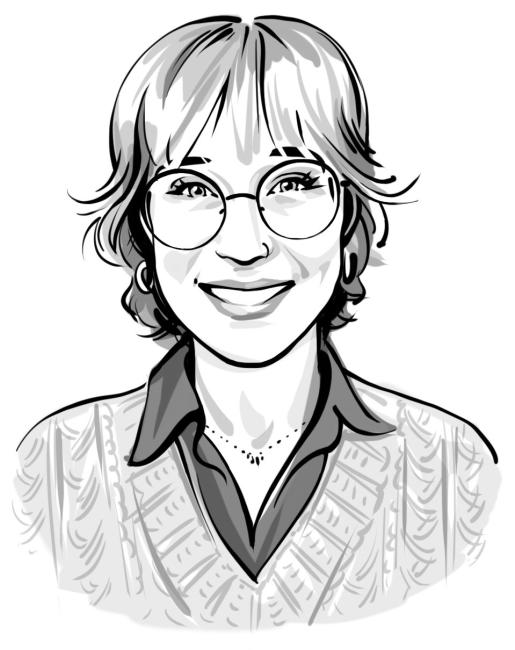February 2024: Handpicked
Each month we ask a member of our staff or a special friend to select favorite stories, books, interviews, or articles from our online collections. This month’s picks are by Maya González.

Maya González is a historian of contemporary Holocaust memory in the United States. She has an MA in history and public history from the University of Massachusetts Amherst and a BA in history and Jewish history from the University of California Santa Cruz. She has worked at the USHMM Simon-Skjodt Center for the Prevention of Genocide, the JFCS Holocaust Center in San Francisco, and the Institute of Holocaust, Genocide, and Memory Studies at UMass. She is the Yiddish Book Center’s 2023–2024 Harriett and Seymour Shapiro Fellow in Bibliography.
This conversation brings together two of my long-time inspirations, Marjorie Agosín and Ruth Behar, who are both Jewish Latina immigrants and self-proclaimed “memory keepers.” Agosín and Behar describe the geographic and linguistic contours of their memories, from their respective home countries of Chile and Cuba and beyond. They dive into a question that I often consider in my work as a Holocaust and genocide educator: How do we write histories of violence for a younger audience? “Hope is found in the truth,” says Agosín, discouraging the audience from shielding children, or any reader, from learning about the difficult parts of our histories.
Watch Geographies of the Soul (in English)
“A nay kleyd” (“A New Dress”) performed by Adah Hetko
After fleeing genocidal violence in Poland in 1941, writer and poet Rokhl Korn often lamented the loss of her home in her writings. This poem expresses Korn’s aching disappointment with her own inability to adjust to her new environment as she attempts to settle into an unfamiliar life in postwar Montreal. Apart from its original content, Korn’s expression of disconnection from her own body resonates deeply with the part of me that is dedicated to reproductive justice. Adah Hetko’s melodic adaptation gives voice to Korn’s grief, while her voice soothes the wounds it describes.
Watch “A nay kleyd” (in Yiddish and English)
In this oral history excerpt, Irena Klepfisz remembers participating in akademyes (Holocaust memorial ceremonies) as a nine-year-old emigre in Sweden. Wearing the label of “Holocaust survivor” and being the daughter of Warsaw Ghetto Uprising hero Michał Klepfisz, she was often called upon during these ceremonies to represent the 1.5 million child martyrs of the Holocaust. She describes the experience as “destructive” and “traumatizing.” In a landscape of Holocaust memory that often prioritizes triumphalist narratives, Klepfisz refocuses her narrative to center the vulnerability and humanity of survivors.
Watch an oral history excerpt with Irena Klepfisz (in English)
Khaneke: di tokhter fun der lererin sheyne
This illustrated book by Yankev Pat is an accessible read for Yiddish learners, especially those interested in Yiddish representations of the Holocaust. Taking place in his hometown of Bialystok, the book follows Pat’s three sisters as they flee Nazi violence with their children. The story contains a wealth of communal knowledge, including songs from the Bialystok ghetto, moments from the destruction of Bialystok’s Jewish community, and descriptions of Bialystok’s lively prewar landscape. The narrative is complemented by thirty-three stunning illustrations by papercutting artist Tsirl Waletzky. In reading this book, I hope that Yiddish readers will feel a renewed curiosity to learn about the Holocaust from Yiddish sources.
Read Khaneke: di tokhter fun der lererin sheyne (in Yiddish)
Shtendiḳ zayn zol di mame! zamlung fun ḳindershe gemeln
To end on a lighter note, I’d like to share a precious collection of children’s illustrations published in 1986. Each picture shows the love and care with which children observe their mothers and the world that revolves around them. Much like these young folks, I’m also compelled to make art inspired by Yiddish traditions like woodcut printing—and, of course, I’m inspired by my mom, who taught me to observe the world with an open heart and mind.
Read Shtendiḳ zayn zol di mame! zamlung fun ḳindershe gemeln (in Yiddish)
Q&A
Tell us about your selections and what they say about your relationship with Yiddish language and culture.
As a historian of Holocaust memory, I am drawn to the representations of trauma and displacement within our collections. Since my first foray into Jewish history studying Holocaust film, I have remained fascinated with deconstructing national narratives of the Holocaust. As a borderless diaspora language, Yiddish has much to offer by way of reimagining the relationship between national memory and collective memory. I hope that my selections offer diverse perspectives on how memory functions on individual and communal levels.
My selection highlights a range of memory keepers—survivors, witnesses, academics, and creatives—all of whom inspire my approach to historical research. Notably, I’ve highlighted stories of, about, and for children. For me, studying Yiddish feels like a return to childhood, where unadulterated curiosity is a valuable resource. This curiosity provides me with new perspectives on childhood and memory. Although we depend on children to inherit and pass on the histories of their elders, scholars often overlook them as witnesses and historical agents in their own right. They are curious and honest about the world, and we should be too.
What are you working on next?
I’m currently working on a project focused on the life and writings of Chaim Margoles-Davidzon, an anti-fascist, pro-Soviet Yiddish writer who was active in New York in the first half of the twentieth century. After my time as a fellow comes to a close, I will return to the University of Massachusetts Amherst for my PhD in history. There I will continue studying how Yiddish language and culture are presented and instrumentalized in American Holocaust museums.
